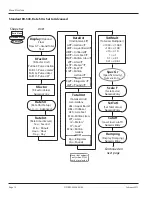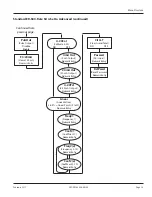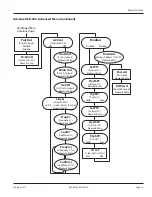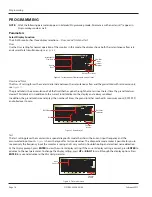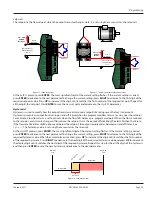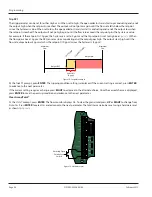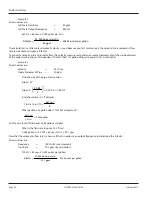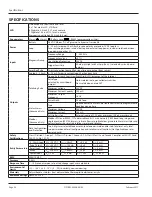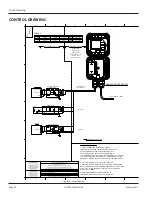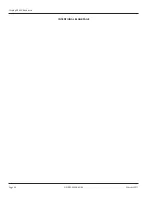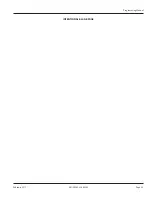
Password*
The password setting restricts access to the
Programming
and
Extended Programming
modes Initially, the password is set to all
zeros and any user can modify the parameter settings To change the password, press
ENTER
at the
Passwd
prompt The first
digit flashes Press
UP
to increment the digit and
RIGHT
to advance to the next digit After entering all digits, press
ENTER
to
store the password and advance to
RstPswd
The new password is now required to enter either programming mode With this
password set, any user is able to reset the stored totals on the monitor
Reset Password*
The reset password parameter restricts resetting the totals on the monitor The
Passwd
must also be set to restrict the total
reset Initially, the password is set to all zeros and any user can reset the stored totals on the monitor To change the password,
press
ENTER
at the
RstPswd
prompt The first digit flashes Press
UP
to increment the digit and
RIGHT
to advance to the next
digit After entering all digits, press
ENTER
to store the password and return to the
Fluid
parameter The reset password is now
required to reset the totals on the monitor
OTEE:
N
Entering a password in the
Passwd
screen and leaving the password blank in the
RstPswd
screen allows for total resets
(not requiring a password), but restricts programming modification
K-FACTORS EXPLAINED
The K-factor (with regards to flow) is the number of pulses that must be accumulated to equal a particular volume of fluid You
can think of each pulse as representing a small fraction of the totalizing unit
An example might be a K-factor of 1000 (pulses per gallon) This means that if you were counting pulses, when the count total
reached 1000, you would have accumulated 1 gallon of liquid Using the same reasoning, each individual pulse represents an
accumulation of 1/1000 of a gallon This relationship is independent of the time it takes to accumulate the counts
The frequency aspect of K-factors is a little more confusing because it also involves the flow rate The same K-factor number,
with a time frame added, can be converted into a flow rate If you accumulated 1000 counts (one gallon) in one minute, then
your flow rate would be 1 gpm The output frequency, in Hz, is found simply by dividing the number of counts (1000) by the
number of seconds (60) to get the output frequency
1000 ÷ 60 = 16 6666 Hz If you were looking at the pulse output on a frequency counter, an output frequency of 16 666 Hz
would be equal to 1 gpm If the frequency counter registered 33 333 Hz (2 × 16 666 Hz), then the flow rate would be 2 gpm
Finally, if the flow rate is 2 gpm, then the accumulation of 1000 counts would take place in 30 seconds because the flow rate,
and hence the speed that the 1000 counts is accumulated, is twice as great
Calculating K-factors
Many styles of flow meters are capable of measuring flow in a wide range of pipe sizes Because the pipe size and volumetric
units the meter will be used on vary, it may not possible to provide a discrete K-factor In the event that a discrete K-factor is
not supplied then the velocity range of the meter is usually provided along with a maximum frequency output
The most basic K-factor calculation requires that an accurate flow rate and the output frequency associated with that flow
rate be known
Example 1:
Known values are:
Frequency
=
700 Hz
Flow Rate
=
48 GPM
700 Hz × 60 sec = 42,000 pulses per min
K-factor
42,000 pulses per min
48 gpm
875 pulses per gallon
=
=
K-factors Explained
DSY-PM-00028-EN-02
Page 25
February 2017
Summary of Contents for ER-500
Page 1: ...Display ER 500 Advanced DSY PM 00028 EN 02 February 2017 Programming Manual...
Page 2: ...ER 500 Flow Monitor Page ii February 2017 DSY PM 00028 EN 02...
Page 4: ...ER 500 Flow Monitor Page iv February 2017 DSY PM 00028 EN 02...
Page 34: ...Display ER 500 Advanced INTENTIONAL BLANK PAGE DSY PM 00028 EN 02 Page 34 February 2017...
Page 35: ...Programming Manual INTENTIONAL BLANK PAGE DSY PM 00028 EN 02 Page 35 February 2017...


